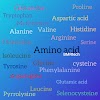Methionine | History | Structure | Function........
METHIONINE AMINO ACID
Methionine (symbol Met or M) is an essential amino acid in humans.
Or
Methionine is one of nine essential amino acids in humans (provided by food), Methionine is required for growth and tissue repair. A sulphur-containing amino acid, methionine improves the tone and pliability of skin, hair, and strengthens nails. Involved in many detoxifying processes, sulphur provided by methionine protects cells from pollutants, slows cell aging, and is essential for absorption and bio-availability of selenium and zinc.
Methionine is an essential amino acid (there are 9 essential amino acids) required for normal growth and development of humans, other mammals, and avian species. In addition to being a substrate for protein synthesis, it is an intermediate in transmethylation reactions, serving as the major methyl group donor in vivo, including the methyl groups for DNA and RNA intermediates. Methionine is a methyl acceptor for 5-methyltetrahydrofolate-homocysteine methyltransferase (methionine synthase), the only reaction that allows for the recycling of this form of folate, and is also a methyl acceptor for the catabolism of betaine.
As the substrate for other amino acids such as cysteine and taurine, versatile compounds such as SAM-e, and the important antioxidant glutathione, methionine plays a critical role in the metabolism and health of many species, including humans. It is encoded by the codon AUG.
Properties :-
Chemical formula :- C5H11NO2S
Molar mass :- 149.21 g·mol−1
Appearance :- White crystalline powder
Density :- 1.340 g/cm3
Melting point :- 281 °C (538 °F; 554 K) decomposes
Thermodynamic data :- Phase behaviour (solid–liquid–gas)
Structure-
HISTORY :-
Methionine is also an important part of angiogenesis, the growth of new blood vessels. Supplementation may benefit those suffering from copper poisoning. Overconsumption of methionine, the methyl group donor in DNA methylation, is related to cancer growth in a number of studies. Methionine was first isolated in 1921 by John Howard Mueller.
SYNTHESIS :-
Chemical Synthesis :-
The industrial synthesis combines acrolein, methanethiol, and cyanide, which affords the hydantoin. Racemic methionine can also be synthesized from diethyl sodium phthalimidomalonate by alkylation with chloroethylmethylsulfide (ClCH2CH2SCH3) followed by hydrolysis and decarboxylation.
Biosynthesis :-
Enzymes involved in the E. coli trans-sulfurylation route of methionine biosynthesis:
Aspartokinase
Aspartate-semialdehyde dehydrogenase
Homoserine dehydrogenase
Homoserine O-transsuccinylase
Cystathionine-γ-synthase
Cystathionine-β-lyase
Methionine synthase (in mammals, this step is performed by homocysteine methyltransferase or betaine—homocysteine S-methyltransferase.)
USES :-
DL-Methionine is sometimes given as a supplement to dogs; It helps reduce the chances of kidney stones in dogs. Methionine is also known to increase the urinary excretion of quinidine by acidifying the urine. Aminoglycoside antibiotics used to treat urinary tract infections work best in alkaline conditions, and urinary acidification from using methionine can reduce its effectiveness. If a dog is on a diet that acidifies the urine, methionine should not be used. Methionine is allowed as a supplement to organic poultry feed under the US certified organic program Methionine can be used as a nontoxic pesticide option against giant swallowtail caterpillars, which are a serious pest to orange crops.
SUBSCRIBE FOR MORE INFORMATION........!







0 Comments